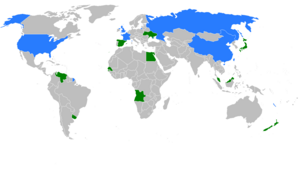Eleição do Conselho de Segurança das Nações Unidas de 2015 Índice Candidatos | Resultados | Referências Menu de navegação«Security Council Elections 2015»«Asian group of nations at UN changes its name to Asia-Pacific group»«Security Council Elections: Options after Saudi Arabia Rejects its Seat»«Senegal favors Morocco's return to AU»«Australia to support Bangladesh for UN Security Council for 2016-17|publicadoBangladesh Business News»«Bangladesh Withdraws from UN Security Council Candidature in Japan's Favour»«Press Conference by Minister for Foreign Affairs Seiji Maehara»«Ukraine to seek election to UN Security Council in autumn»«Uruguay vuelve al Consejo de Seguridad de ONU tras 50 años»«General Assembly Elects Egypt, Japan, Senegal, Ukraine, Uruguay as Non-Permanent Members of Security Council for 2016–2017»e
Eleições em 2015Eleições do Conselho de Segurança das Nações Unidas
15 de outubro201570.ª sessãoAssembleia Geral das Nações Unidassede da Organização das Nações UnidasNova IorqueConselho de Segurança das Nações Unidas1 de janeiro2016EgitoSenegalUruguaiJapãoUcrânia
‹ 2014 •  • 2016 › • 2016 › | |||||||||||
Eleição do Conselho de Segurança das Nações Unidas em 2015 5 (de 10) lugares não permanentes no Conselho de Segurança das Nações Unidas | |||||||||||
15 de Outubro de 2015 | |||||||||||
 | |||||||||||
| Composição do CSNU após a eleição de 2015 | |||||||||||
Membros não-permanentes | |||||||||||
Titular | Eleito | ||||||||||
A Eleição do Conselho de Segurança das Nações Unidas em 2015 ocorreu em 15 de outubro de 2015 durante a 70.ª sessão da Assembleia Geral das Nações Unidas na sede da Organização das Nações Unidas, em Nova Iorque.[1] A eleição determinou os novos ocupantes dos cinco lugares não permanentes no Conselho de Segurança das Nações Unidas (CSNU) para mandatos de dois anos com início em 1 de janeiro de 2016.
Em concordância com as normas de rotatividade do Conselho de Segurança, os dez lugares não permanentes no Conselho alinham-se aos diversos blocos regionais em que habitualmente os estados-membros da ONU se dividem com fins eleitorais e representativos. São realizadas anualmente eleições para escolher cinco membros temporários, com mandato de dois anos a partir do ano subsequente. Na eleição de 2015, os escolhidos foram os seguintes países:
- Dois da África (Chade e Nigéria)
- Um da Ásia-Pacífico (Jordânia)[2]
- Um da América Latina e Caribe (Chile)
- Um do Grupo dos Estados da Europa Ocidental e Outros (Lituânia)
Os cinco membros servirão no Conselho de Segurança durante o biênio 2016-2017. Os países eleitos foram Egito, Senegal, Uruguai, Japão e Ucrânia. Em cada votação, havia o mesmo número de candidaturas e vagas na cédula.
Índice
1 Candidatos
1.1 África
1.2 Ásia-Pacífico
1.3 Europa Oriental e Outros
1.4 América Latina e Caribe
2 Resultados
3 Referências
Candidatos |
África |
 Egito[3]
Egito[3] Senegal[4]
Senegal[4]
Ásia-Pacífico |
 Bangladesh[5] — Retirou a candidatura em favor do Japão.[6]
Bangladesh[5] — Retirou a candidatura em favor do Japão.[6] Japão[7]
Japão[7]
Europa Oriental e Outros |
 Ucrânia[8]
Ucrânia[8]
América Latina e Caribe |
 Uruguai[9]
Uruguai[9]
Resultados |
África e Ásia-Pacífico[10] | |
| Membro | Votação 1 |
|---|---|
187 | |
184 | |
179 | |
| Abstenções | 1 |
| Maioria requerida | 127 |
América Latina/Caribe[10] | |
185 | |
| Abstenções | 6 |
| Maioria requerida | 124 |
Europa Oriental e Outros[10] | |
177 | |
| Abstenções | 14 |
| Maioria requerida | 118 |
Referências
↑ «Security Council Elections 2015» (PDF). Security Council Report
↑ «Asian group of nations at UN changes its name to Asia-Pacific group». Radio New Zealand International
↑ «Security Council Elections: Options after Saudi Arabia Rejects its Seat». What's in Blue?. 18 de outubro de 2013
↑ «Senegal favors Morocco's return to AU». Saudi Gazette. 21 de março de 2013
↑ «Australia to support Bangladesh for UN Security Council for 2016-17|publicadoBangladesh Business News». 16 de abril de 2012
↑ «Bangladesh Withdraws from UN Security Council Candidature in Japan's Favour». NDTV. 7 de setembro de 2014
↑ «Press Conference by Minister for Foreign Affairs Seiji Maehara». Ministério de Relações Exteriores do Japão. 11 de janeiro de 2011
↑ «Ukraine to seek election to UN Security Council in autumn». UNIAN. 25 de maio de 2015
↑ «Uruguay vuelve al Consejo de Seguridad de ONU tras 50 años». El Observador. 16 de outubro de 2015
↑ abc «General Assembly Elects Egypt, Japan, Senegal, Ukraine, Uruguay as Non-Permanent Members of Security Council for 2016–2017». Nações Unidas. 15 de outubro de 2015